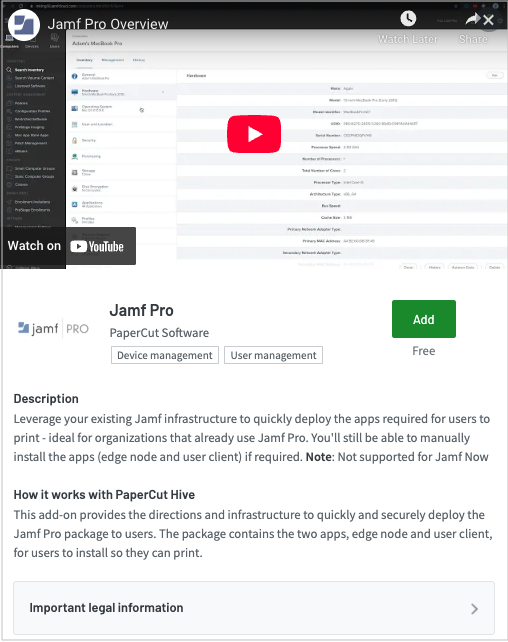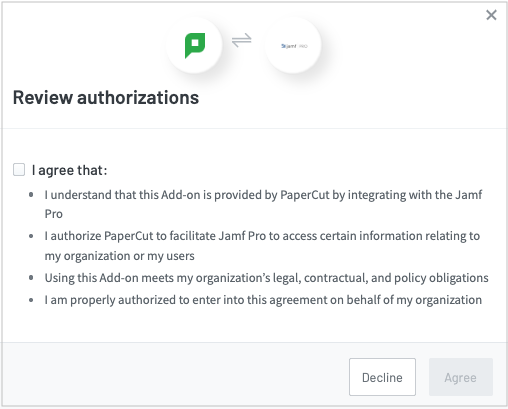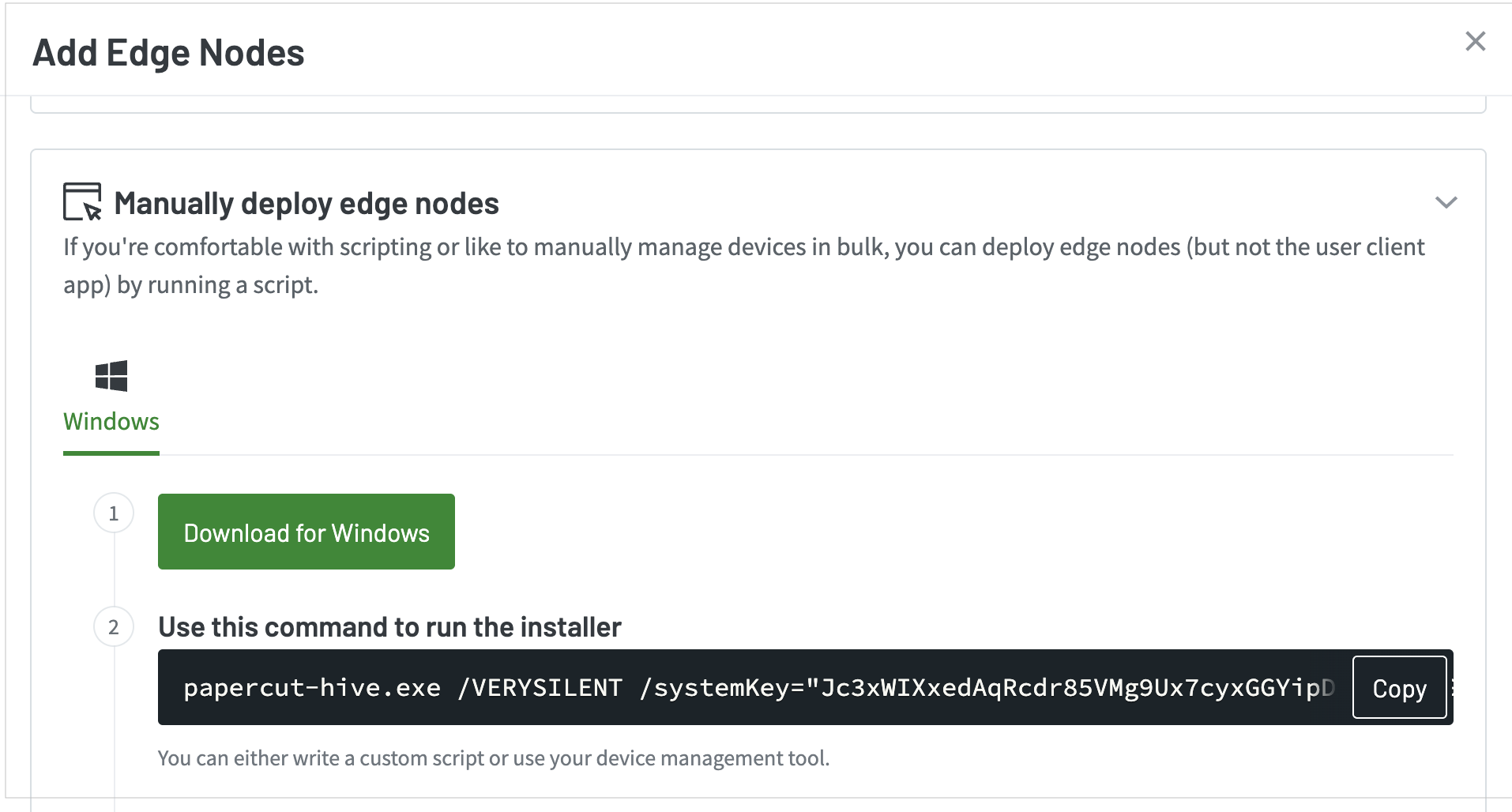Kandji is the Apple device management and security platform that empowers secure and productive global work. With Kandji’s Device Management, Apple devices transform themselves into enterprise-ready endpoints, with all the right apps, settings, and security controls in place.
This topic explains how to deploy the PaperCut Hive Agent to a macOS client managed by Kandji.
Summary of deploying with Kandji
The PaperCut provided PaperCut Hive Agent is a .zip file that contains multiple components. You can modify an installation script to include your PaperCut configuration information, then Kandji installs the .zip file and runs the script on Mac computers.
In summary, to deploy the PaperCut Hive Agent using Kandji:
- (Optional) Create a Kandji Login & Background Items Library Item.
- Download the PaperCut Hive installation file.
- Create a Kandji Custom Apps Library Item.
- Test your deployment.
Prerequisites
The following are required before you can use these instructions:
- A valid Kandji subscription.
- A Kandji administrative account, with the relevant permission to make the changes required.
- Kandji supports macOS 11.0 (Big Sur) or higher. The workstations should already be enrolled into Kandji.
Deploying the PaperCut Hive or Pocket client software to end-user devices
1. (Optional) Create a Kandji Login and Background Items Library Item.
Note: If you’ve already created a Login & Background Items Library Item for PaperCut, you can rename it to reflect a more general use for PaperCut and scope it to appropriate Blueprints.
Use this optional step to accomplish two things at once on a Mac with macOS 13 Ventura or newer:
prevent users from disabling the PaperCut Print Hive Agent
prevent macOS from displaying the following alert:
“Background Items Added. Software from “PaperCut Software International Pty Ltd” added items that can run in the background. You can manage this in Login Items Settings.”
For more details, see Kandji’s support article at: Configure the Login & Background Items Library Item
Sign in to your Kandji instance, for example, https://your-company.kandji.io or https://your-company.eu.kandji.io.
In the sidebar, select Library.
In the upper-right corner, click Add new.
Select Login & Background Items.
Click Add & Configure.
Enter a name such as PaperCut Hive Agent.
In the Assignment section, click Select Blueprint, then select the Blueprint or Blueprints to assign this Custom Profile to (you can always change the Blueprint selection later).
(Optional) Next to the Rules section, click Add, add one or more Assignment Rules, then click Confirm. Assignment rules limit which devices within the Blueprint will be assigned this Library Item.
Click Add Background Item.
Click the menu for Identifier Type and select Team Identifier.
In the Identifier field, enter B5N3YV5P2H and verify what you’ve entered.
Click Save.
2. Download the PaperCut Hive installation file.
You need to download the macOS PaperCut Pocket or PaperCut Hive Computer app and upload this to your prefered cloud storage location, then cerate a Jumpcloud script to deploy it.
You need to add the Jamf Pro Add-on in PaperCut Pocket or Hive in order to be able to download the PaperCut Pocket or Hive Comupter app zip file.
From the PaperCut Hive or Pocket admin console, in the left menu select Add-ons.
On the Device management tab, locate the Jamf Pro card and click Learn More.

Click Add.

The Review authorizations popup is displayed.

Read the points, select the I agree that: checkbox and select Agree to enable this add-on for your organization.
Select these instructions to open the instructions, then walk through the steps in your instance of Jamf.
Click the Setup instructions tab.

Under Step 1 click on the Download zip file button to download the PaperCut Hive or PaperCut Pocket Computer app zip file to your computer.
Note: Ensure that your browser does not decompress the installation file when you download it. For example, in Safari, choose Safari > Settings, click General, then deselect the option “Open ‘safe’ files after downloading.” Click this button to download the .zip file:
Close the Jamf Pro add-on instructions page.
On the PaperCut Hive Admin console, go to Manage > Edge Mesh and click Add edge nodes.

PaperCut Pocket/PaperCut Hive admin interface - Add an edge node
Select Manually deploy edge nodes.
Under Step 2, click the Copy button to copy the command line, and then paste it into a text editor. You'll need the
/systemkeyvalue later.
3. Create a Kandji Custom Apps Library Item.
This section also includes optional steps 13-16 to add a Preinstall Script to install Rosetta for a Mac with Apple silicon.
Sign in to your Kandji instance, for example, https://your-company.kandji.io or https://your-company.eu.kandji.io.
In the sidebar, select Library.
In the upper-right corner, click Add new.
Select Custom Apps.
Click Add & Configure.
Enter a name such as PaperCut edge node & Print Client.
In the Assignment section, click Select Blueprint, then select the Blueprint or Blueprints to assign this Custom Profile to (you can always change the Blueprint selection later).
(Optional) Next to the Rules section, click Add, add one or more Assignment Rules, then click Confirm. Assignment Rules limit which devices within the Blueprint will be assigned this Library Item.
In the Installation section, select the installation method required from the drop-down menu. You can choose your deployment method from 1 of the 3 available deployment methods below;
Install once per device
This installs the client once only.
Install on-demand from Self Service
Allow the user to install the client using the self-service option.
Audit and enforce
Use an audit script to check for files, folders, apps, settings, and more. A failed audit script will trigger a package (re-)installation. Failure is detected when a script's exit code is anything other than 0. An example of a bash audit script for PaperCut Hive is:
#!/bin/bash # # Audit script for Kandji — verifies four PaperCut Hive files using mdfind files=( "/Library/PaperCut Hive/data/config/cloud-region.conf" "/Library/PaperCut Hive/data/config/coordinator.ident" "/Library/PaperCut Hive/pc-edgenode-service.conf" "/Library/PaperCut Hive/pc-edgenode-service" ) missing=() for file in "${files[@]}"; do if ! mdfind -onlyin "/Library/PaperCut Hive" -name "$(basename "$file")" | grep -Fxq "$file"; then missing+=("$file") fi done if [[ ${#missing[@]} -eq 0 ]]; then echo "PASSED: All required PaperCut Hive files are present." exit 0 else echo "FAILED: The following file(s) are missing:" for f in "${missing[@]}"; do echo "- $f" done exit 1 fi(Optional) Configure the Self Service section.
In the Install details section, select ZIP File.
In the Unzip Location field, enter /var/tmp; the script expects the installation folder to be in that location.
Below the Unzip Location section, click Add Preinstall Script.
In a different web browser tab, visit the page that contains Kandi’s script that installs Rosetta if it’s not already installed: https://github.com/kandji-inc/support/blob/main/Scripts/InstallRosetta2.sh
Click the Copy raw contents button, which looks like two squares, and is displayed to the left of the Trash button.
In the Custom Apps Library Item that you are working on in Kandji, in the Preinstall Script field, paste the script you just copied.
In the ZIP File section, click the click to upload link.
In the Choose Files to Upload window, navigate to the folder that contains your .zip file.
Select the papercut-hive.zip file.
Click Upload.
Click Add Postinstall Script.
Copy the following script by clicking the Copy button. Note that this script needs to be updated by replacing 'xxxxxxxxxxxxxxxxxxxxxxxxxxxxxxxxxxxxxxxxxxxxxxxxxx' with the value of your organisations 'systemkey' you noted down earlier.
Replace 'yy' with the regional data center region code, for example, au,ca, us,eu,uk, & 'zz' with the orgId of your organization.
#!/usr/bin/env zsh # Kandji automatically unzips the zip file in the Unzip Location. # Change the following if you change the Unzip Location. HIVE_INSTALLER_PATH="/var/tmp/hive_installer" # Get the current logged in user excluding loginwindow, _mbsetupuser, and root current_user=$(/usr/sbin/scutil <<<"show State:/Users/ConsoleUser" | /usr/bin/awk '/Name :/ && ! /loginwindow/ && ! /root/ && ! /_mbsetupuser/ { print $3 }' | /usr/bin/awk -F '@' '{print $1}') # Make sure that we can find the most recent logged-in user if [[ $current_user == "" ]]; then # Because someone other than the current user was returned, we are going to look at # who uses this Mac the most, then set the current user to that user. current_user=$(/usr/sbin/ac -p | /usr/bin/sort -nk 2 | /usr/bin/grep -E -v "total|admin|root|mbsetup|adobe" | /usr/bin/tail -1 | /usr/bin/xargs | /usr/bin/cut -d " " -f1) fi # Install the PaperCut edgenode with system administrator privileges # This code is private to your PaperCut organisation. Please do not share it # Replace 'yy' with the regional data centre region code e.g. au,us,eu,uk # Replace 'zz' with your orgID cd ${HIVE_INSTALLER_PATH} ./install.sh xxxxxxxxxxxxxxxxxxxxxxxxxxxxxxxxxxxxxxxxxxxxxxxxxxxxxxxxxxxxxxxxxxxxxxxxxxxxxxxxxxxxxxxxxxxxxxxxxxxx yy zz # Install the PaperCut client as the current user /usr/sbin/chown -R $current_user ${HIVE_INSTALLER_PATH} /usr/bin/su - "$current_user" -c "cd ${HIVE_INSTALLER_PATH} && ./install.sh install_client"In the Postinstall Script field, paste the script you copied in the previous step.
Click Save.
4. Test your deployment.
Log in to a Mac that is in a Blueprint that contains the Library Items that you just configured.
(Optional) The Login & Background Items Library Item should be automatically deployed as soon as you create and save the Library Item. To confirm this, open System Settings > Profiles (for macOS 13 Ventura or newer) or System Preferences > Profiles (for macOS 12 Monterey or earlier) to confirm the Login Items Policy profile is displayed.
(Optional) If you've configured the Custom Apps Library Item to be available in Self Service, it should be automatically deployed and available in Self Service within 15 minutes. To force the Kandji Agent to check in and install the Custom App Library Item immediately, use the following steps:
Open the Kandji Self Service app.
In the sidebar click Device Info.
Click Sync.
Open System Settings > Printers & Scanners (for macOS 13 Ventura or newer) or System Preferences > Printers & Scanners (for macOS 12 Monterey or earlier).
Confirm that the PaperCut Printer is displayed.
Open the PaperCut Hive invite email for the user and click on the link in that email. This will cause the PaperCut Hive print client on that macOS device to be linked to that user.
Send a test print job and validate in your PapetrCut Hive Admin dashboard in the Job Log you can see the job and it is linked to the correct user.
Post-deployment checks
Spot-check a few macOS computers to ensure the following:
- In Activity Monitor, check the
pc-edgenode-serviceprocess is running.
The computer requires this service to perform Edge Mesh activities such as receiving, replicating, or printing jobs if the PaperCut Cloud Service calls upon it. - In Activity Monitor, check that
pc-print-clientprocess is running.
This is the print client needed to link the end user to PaperCut Pocket or PaperCut Hive and submit jobs via the PaperCut Printer. This process must be running in memory. It provides the functions the user needs to print jobs via the PaperCut Printer.
If either of these is not running, please contact your PaperCut Reseller and provide copies of the logs.
Locations of logs
-
edge node logs - The Setup Log for the edge node service:
/Library/PaperCut Hive/data/logsdirectoryEdge node Setup Log: “Setup Log %date% 00X.txt”
-
print client logs - The print client logs are located in the: ‘~/Library/PaperCut Hive/data/logs’ directory
Note: For macOS, since the print client is installed under the user context, so you’ll need to perform either of the below steps to grab the set of logs:
- Open Finder.
- Hold down the Option key when clicking the Go menu. The library will appear below the current user’s home directory
Or
- Open Finder.
- Click on the Go menu and choose Go to Folder.
- In the popup, type ~/Library and press Enter.






Comments